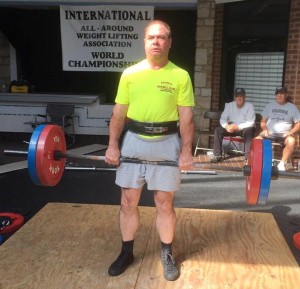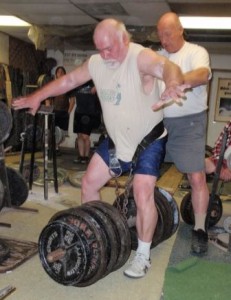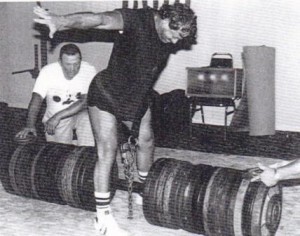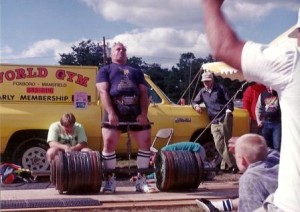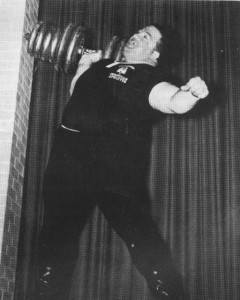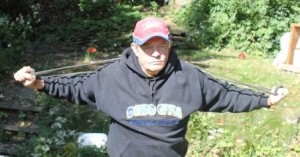By Al Myers
2018 USAWA GRIP CHAMPIONSHIPS
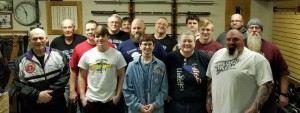
Group picture from the 2018 USAWA Grip Championships.
It was another great year for the USAWA Grip Championships! The Dino Gym had a full room with 14 lifters in attendance – 12 men and 2 women. Thom Van Vleck of the JWC made the trip from Missouri to Kansas to officiate the event. I plan to keep this meet report short as I need to get the results on the website today. I apologize for the long delay in this, but it’s been a busy week for me.
First of all, I want to mention Mary Mac and her return to the USAWA. Mary has been fighting hard against some medical issues this past year, so it was a very special seeing her back in action in the Dino Gym. And WOW, she still has super strength in those fingers as she did a 155 Ring Fingers Deadlift!
I want to give a big congrats to Tressa for winning Overall Best Womens Lifter of the 2018 USAWA Grip Championships. She has competed at several Grip Championships, but this was her first time being the Womens Overall. She now joins a very select group of past Grip Champions (which includes RJ Jackson, Emily Burchett, Mary McConnaughey, and Felecia Simms).
The Mens Division was loaded with grippsters! I won’t go into detail with all the specific GREAT LIFTS, as there were many. For the first time ever, the Mens Junior Class was extremely competitive. Calvin, Cole, and Jared lifted like seasoned veterans and put up great numbers. All three totaled over 750 pounds, with Calvin just edging out Cole (873 to 860 pts) for Best Junior Lifter. That’s as close as it gets.
Another tight battle was in the 75-79 age group between Dean and Denny. In the end, Dean just pulled out Best Lifter in the 75-79 by only 11 points!
I was so glad to see Jason again, along with John. I could tell the two of them were having a blast lifting alongside with their sons, and if it wasn’t for that dreaded Ring Finger DL which gave them the fits, they both would have placed much higher overall.
Someone who always gets overlooked in meets within the USAWA (and shouldn’t!!) is the person who puts up the top total of the day. There really should be an award to recognize this accomplishment. At this Grip Championships, this person was Scott Tully who put up the top total at 1197 pounds. Scott also had the top lift in 3 of the 5 events (strict pinch grip 162 lbs., 1 arm VB 200 lbs., and the pinch grip DL of 500 pounds). Scott becomes the first person to perform a 500 pinch grip deadlift.
Ben has been a consistent player at the Grip Championships through the years. I’m not sure if he has even missed any. Ben’s a true gentleman lifter, and always super supportive of the other lifters. He is a veteran of the grip, and freely shares training advice. He finished strong with an overall 4th place finish this year, just slightly behind last years Overall Grip Champ Chad Ullom (988 to 975) who finished 3rd overall.
And finally, for those of you that had to wonder if my dad was going to speak to me the next day after how everything went down between the two of us at the meet. The answer is YES, he forgave me for edging him out by only 1 point!!
MEET RESULTS:
2018 USAWA Grip Championships
Dino Gym
Holland, Kansas
February 10th, 2018
Meet Director: Al Myers
Meet Scorekeeper: Al Myers
Meet Official (1 official system used): Thom Van Vleck
Lifts: Pinch Grip – Strict, Deadlift – Fulton Bar One Arm, Vertical Bar Deadlift – 1 Bar 2″ One Hand, Deadlift – Fingers Ring, Pinch Grip Deadlift
WOMENS DIVISION
| LIFTER |
AGE |
BWT |
PGS |
FB1 |
VB1 |
DLR |
PGD |
TOT |
PTS |
| Tressa Brooner |
56 |
134 |
52 |
75R |
80R |
65 |
150 |
422 |
569.1 |
| Mary McConnaughey |
58 |
125+ |
62 |
90R |
80R |
155 |
190 |
577 |
495.3 |
4th Attempts for Record:
Tressa Brooner: VB DL 2″ Right 85 lbs.
Tressa Brooner: Pinch Grip DL 175 lbs.
Mary McConnaughey: Pinch Grip DL 200 lbs.
MENS DIVISION
| LIFTER |
AGE |
BWT |
PGS |
FB1 |
VB1 |
DLR |
PGD |
TOT |
PTS |
| Al Myers |
51 |
229 |
132 |
175R |
195L |
170 |
475 |
1147 |
1066.4 |
| LaVerne Myers |
73 |
236 |
112 |
175L |
180R |
171 |
335 |
973 |
1065.4 |
| Chad Ullom |
46 |
241 |
122 |
176R |
180R |
215 |
450 |
1143 |
988.4 |
| Ben Edwards |
42 |
228 |
142 |
160R |
185R |
135 |
400 |
1022 |
875.6 |
| Calvin Heit |
16 |
152 |
102 |
100R |
135L |
135 |
280 |
752 |
873.5 |
| Cole Janzen |
16 |
169 |
122 |
151R |
140R |
80 |
300 |
793 |
860.3 |
| Scott Tully |
42 |
350 |
162 |
180R |
200R |
155 |
500 |
1197 |
833.6 |
| Dean Ross |
75 |
237 |
67 |
105R |
125L |
125 |
230 |
652 |
722.8 |
| Denny Habecker |
75 |
186 |
67 |
110R |
120R |
65 |
200 |
562 |
711.7 |
| Jason Payne |
52 |
325 |
152 |
130L |
160R |
0 |
400 |
842 |
665.3 |
| Jared Payne |
16 |
279 |
112 |
130R |
150R |
95 |
280 |
767 |
633.9 |
| John Janzen |
52 |
297 |
132 |
130R |
130L |
0 |
330 |
722 |
594.9 |
4th Attempts for Record:
Calvin Heit: VB DL 2″ 1 Bar Left Hand 155 lbs.
Jared Payne: VB DL 2″ 1 Bar Right Hand 160 lbs.
Calvin Heit: DL Ring Fingers 156 lbs.
Dean Ross: DL Ring Fingers 140 lbs.
Calvin Heit: Pinch Grip DL 300 lbs.
Cole Janzen: Pinch Grip DL 330 lbs.
Jason Payne: Pinch Grip DL 420 lbs.
Denny Habecker: Pinch Grip DL 220 lbs.
BEST LIFTER AWARDS
Womens Best Master – Tressa Brooner
Womens Best Overall Lifter – Tressa Brooner
Mens Best Junior – Calvin Heit
Mens Best 40-44 Age Group – Ben Edwards
Mens Best 45-49 Age Group – Chad Ullom
Mens Best 50-54 Age Group – Al Myers
Mens Best 70-74 Age Group – LaVerne Myers
Mens Best 75-79 Age Group – Dean Ross
Mens Best Overall Lifter – Al Myers
RECORD DAY RESULTS
Calvin Heit – 16 Years Old, 151 lbs. BWT
Clean and Push Press: 155 lbs.
Bench Press Reverse Grip: 155 lbs.
Jerk From Rack: 155 lbs.
Vertical Bar DL 1 Bar 1″ Left: 114 lbs.
Bench Press Hands Together: 165 lbs.
Chad Ullom – 46 Years Old, 247 lbs. BWT
Bench Press Feet in Air: 260 lbs.
Roman Chair Sit Up: 90 lbs.
Shoulder Drop: 50 lbs.
Deadlift One Leg: 232 lbs.
Stephen Santangelo – 65 Years Old, 161 lbs. BWT
Finger Lift Right Thumb: 42 lbs.
Finger Lift Left Thumb: 42 lbs.
Finger Lift Right Middle: 130 lbs.
Finger Lift Left Middle: 119 lbs.
Allen Lift: 17 lbs.
LaVerne Myers – 73 Years Old, 238 lbs. BWT
Deadlift Little Fingers: 95 lbs.
Shoulder Drop: 35 lbs.
Deadlift Ciavattone Grip Right Arm: 220 lbs.
Dean Ross – 75 Years Old, 236 lbs. BWT
Deadlift No Thumb Right Arm: 135 lbs.
Clean and Press 2 Dumbbells: 60 lbs.
Bench Press Feet in Air: 185 lbs.
Deadlift 2 Bars: 270 lbs.
Deadlift Little Fingers: 95 lbs.
Denny Habecker – 75 Years Old, 191 lbs. BWT
Clean and Press 2 Dumbbells Heels Together: 90 pounds
Deadlift No Thumb Right Hand: 115 lbs.
Zeigler Clean: 55 lbs.
Clean and Press Behind Neck: 100 lbs.
Holdout Lowered: 45 lbs.
